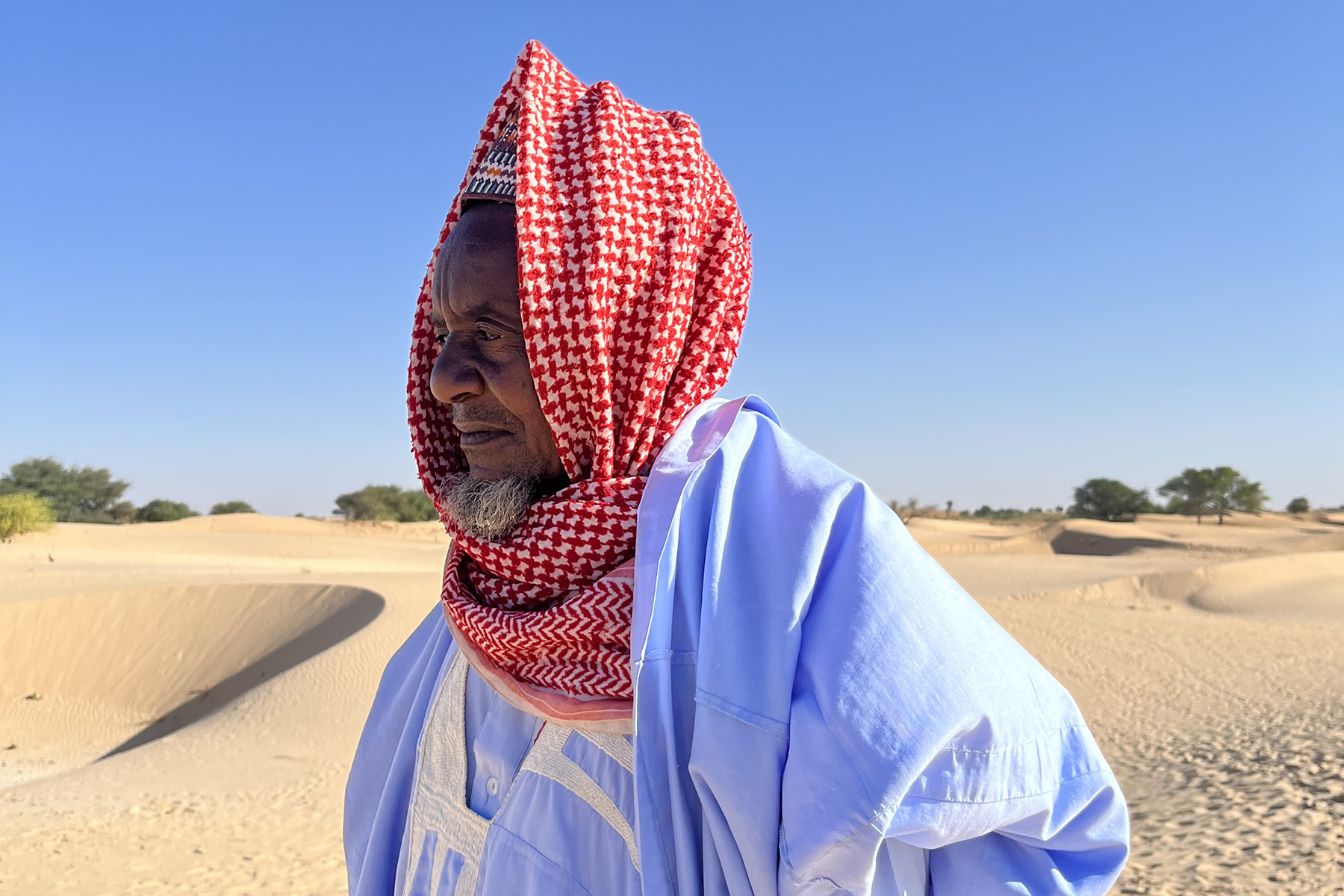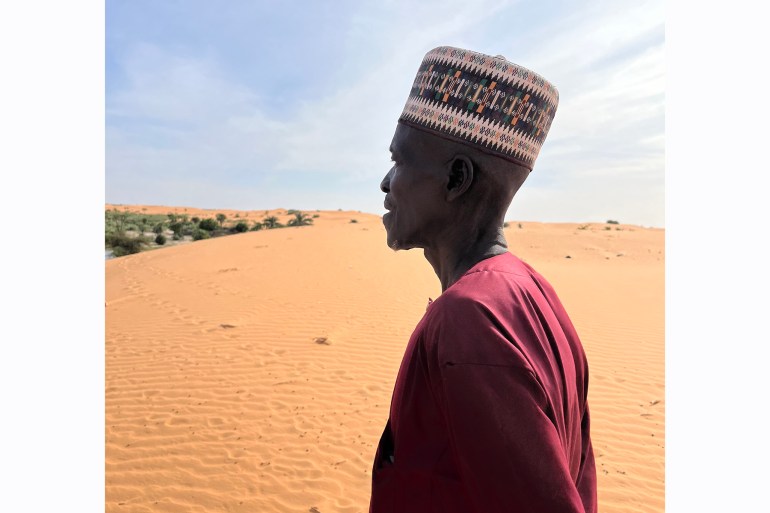
Toshia, Yobe – In a remote corner of Nigeria’s northeastern Yobe state lie communities surrounded by massive sand dunes that stretch as far as the eye can see. In recent years, the desert has moved closer to these communities, a development that continues to impact the lives of the people there.
The town of Toshia in Yunusari Local Government Area, near the border with Niger, is one such community. City trips require old, overcrowded four-wheel-drive vehicles, with passengers crammed into every available space – including the roof – and bouncing around as the vehicle navigates the soft sand.
Bulama Mele was just a child when desert expansion forced his parents to start farming in Niger. The now 40-year-old father of eight says the desert surrounds the city on all sides. After losing his two farms in Toshia to the deserts, he now has to endure the hard commute to run his farm in Niger.
The desert has not only made commuting more difficult, but has also significantly affected living conditions.
Others have also suffered heavy losses as the environmental crisis continues to decimate dozens of farms and cause food shortages in these areas. Up to ten farms owned by village chief Maigari Isa Bukar, his brothers and his father have been destroyed by the increasing desert.
And like his father, Bukar was also expelled from his homeland.
Al Jazeera spoke to other residents who said the sand had also buried more than 20 homes in recent years. As a result, land has become so scarce that people are now returning to rebuild abandoned areas.
Twenty years ago, Bukar said, his farm produced about 20 to 30 bags of beans, millet, peanuts and sorghum. However, he is currently unable to harvest even a single bag as agricultural conditions have deteriorated. “Life has become more difficult for us because there is no food and we are hungry and have nowhere to grow anything,” he told Al Jazeera.
Due to the lack of grass, the animals can no longer walk around and eat; the livestock in the community are fed on the little forage that the farmers can collect on the farm. As a result, milk production from cattle and goats has declined. Some of the animals have even died from starvation-related diseases.
“A dangerous topic”
In the neighboring government district of Yusufari, life in Tulo-Tulo – also near the Niger border and on the edge of the desert – has changed for the residents.
“The impact of desert encroachment is more than what we are describing to you, we are just giving a snippet,” said 61-year-old Dauda Maigari, a millet, sorghum and bean farmer. The changing climate limits his family’s ability to farm and raise livestock, and he begins to worry about his ability to provide for his 18 children and two wives.
Maigari said the desert has swallowed up about 16 farms, including his, and expanded into surrounding areas. “For example, you see that the wind is blowing in this direction. Let’s say this building is the focal point this month. When we come back next year you will see that it has moved forward 25 meters.”
The displacement of people and their livelihoods across the Sahara is a “dangerous issue,” said Lawan Cheri, a lecturer in public administration at the Federal Polytechnic in Damaturu, the state capital.
He explained that the desert is creeping into the Yobe at a rate of about 0.6 kilometers per year (0.37 miles), meaning the desert is expanding by at least two kilometers (1.24 miles) every three years.
The encroachment into the desert has led to a drastic decline in available trees and contributed to rainfall shortages, experts say.
“It is scientific … that the loss of vegetation has affected rainfall patterns,” said Usman Ali Busuguma, regional director of the African Climate Change Research Center (ACCREC) in Maiduguri, the capital of neighboring Borno state.
This significant decrease in rainfall has exacerbated household difficulties. Farmers said although it rained heavily two years ago, the amounts this year were dismal.
“We used to be able to get water easily, but now we have to try harder, and this is even groundwater, not rainwater,” Maigari said. The looseness of the desert soil also affects the flow of water from boreholes, especially if iron pipes are not inserted quickly, he added.

‘Plant more trees’
Analysts believe that among the causes of desert encroachment into the semi-arid region is massive deforestation caused by low-income households that use wood as a primary source of energy for cooking.
Yobe’s population has increased from 2.3 million people in Nigeria’s last census in 2006 to an estimated four million people today – a 42 percent increase. With this growth, demand for agricultural land and cooking fuels has increased.
In May, Nigeria’s newly elected government scrapped a controversial fuel subsidy to ease its purse strings and reform a struggling economy. However, in the short term, this move has resulted in higher pump prices and higher cost of living for Nigerians.
The withdrawal of subsidies has now made access to affordable cooking gas more difficult for large parts of these communities and has led to continued deforestation. But increased fuel prices have also undermined the introduction of irrigated agriculture in Tulo-Tulo.
Stress on the ecosystem has been exacerbated by rising temperatures due to global climate change, analysts said. Locals said higher temperatures have changed the growth patterns of plants with strong roots that previously made it difficult for topsoil to be blown away by the wind.
Now there are calls to save the situation through reforestation.
“There needs to be a conscious policy to plant more trees,” Cheri said, advocating for the introduction of agroforestry – planting trees with food crops – to protect farmland.
An earlier restoration effort by a government agency in the 2000s made a difference. “A few years ago they brought in trees, got a spot and planted them. We saw that this helped,” Maigari said.
There were other attempts.
In 2007, the African Union’s Great Green Wall initiative was launched to combat desertification in the Sahel. By 2014, it had begun in 11 states in northwest and northeast Nigeria where southward expansion of the Sahara is underway.
Five years later, an investigation by a Nigerian publication found that failed contracts and a lack of community involvement in tree selection had jeopardized implementation.
Cheri blamed corruption for her failure. ACCREC’s Busuguma was more mild in his criticism, describing it as an “ambitious and laudable” project that had fallen short of expectations.
“Since its inception, the project has not prioritized community engagement, leaving it feeling disconnected from the communities it is intended to serve,” he said.
Last year the government launched another tree planting drive; The seedlings are being cared for and a borehole has also been made at the site where the trees were planted to facilitate irrigation. There is renewed hope that planting more trees in the area could pave the way for rain to return to the city’s parched farmlands.
Still, Mele wants more government support to ease their suffering and save the city from the desert’s unyielding embrace.
“I can’t say the government did this,” he says. “Without help we will continue to suffer.”






Recent Comments